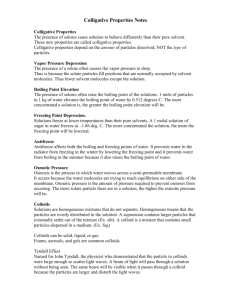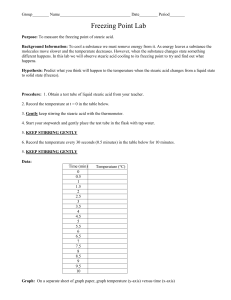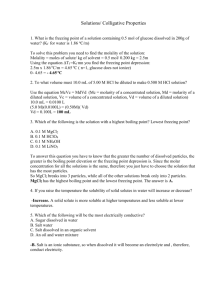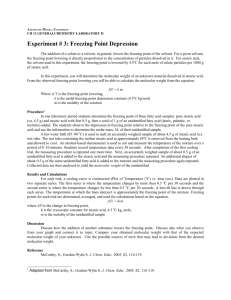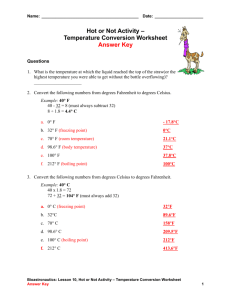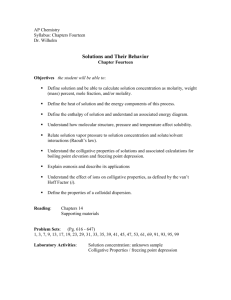Molar Mass Determination from Freezing Point Depression
advertisement
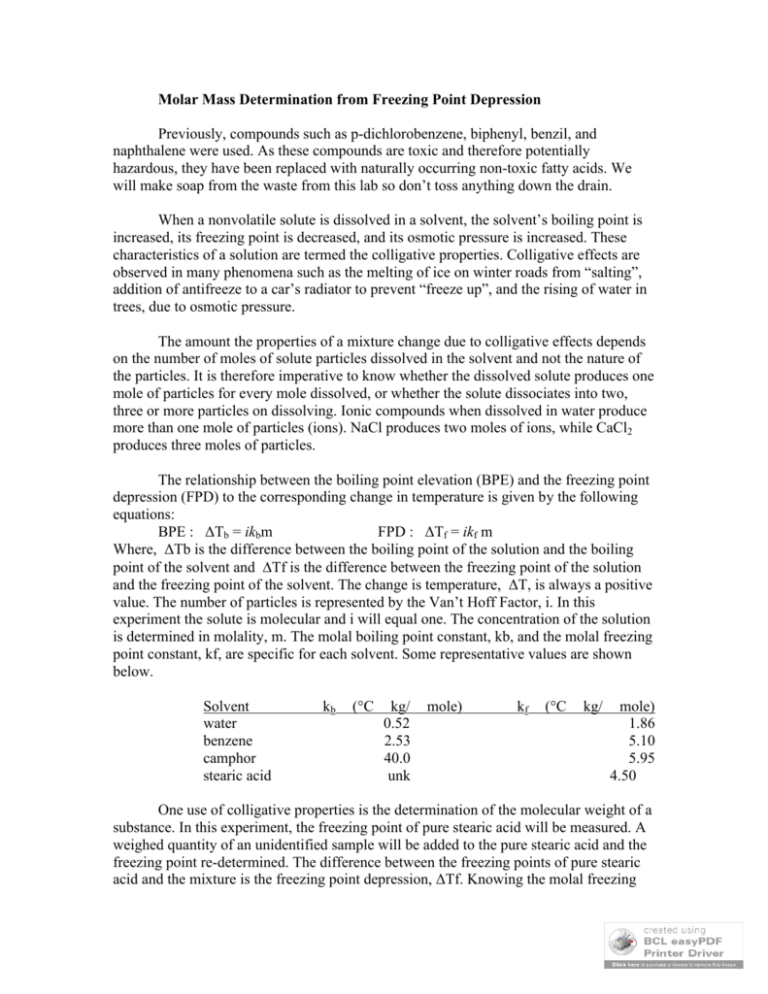
Molar Mass Determination from Freezing Point Depression Previously, compounds such as p-dichlorobenzene, biphenyl, benzil, and naphthalene were used. As these compounds are toxic and therefore potentially hazardous, they have been replaced with naturally occurring non-toxic fatty acids. We will make soap from the waste from this lab so don’t toss anything down the drain. When a nonvolatile solute is dissolved in a solvent, the solvent’s boiling point is increased, its freezing point is decreased, and its osmotic pressure is increased. These characteristics of a solution are termed the colligative properties. Colligative effects are observed in many phenomena such as the melting of ice on winter roads from “salting”, addition of antifreeze to a car’s radiator to prevent “freeze up”, and the rising of water in trees, due to osmotic pressure. The amount the properties of a mixture change due to colligative effects depends on the number of moles of solute particles dissolved in the solvent and not the nature of the particles. It is therefore imperative to know whether the dissolved solute produces one mole of particles for every mole dissolved, or whether the solute dissociates into two, three or more particles on dissolving. Ionic compounds when dissolved in water produce more than one mole of particles (ions). NaCl produces two moles of ions, while CaCl2 produces three moles of particles. The relationship between the boiling point elevation (BPE) and the freezing point depression (FPD) to the corresponding change in temperature is given by the following equations: BPE : ΔTb = ikbm FPD : ΔTf = ikf m Where, ΔTb is the difference between the boiling point of the solution and the boiling point of the solvent and Tf is the difference between the freezing point of the solution and the freezing point of the solvent. The change is temperature, ΔT, is always a positive value. The number of particles is represented by the Van’t Hoff Factor, i. In this experiment the solute is molecular and i will equal one. The concentration of the solution is determined in molality, m. The molal boiling point constant, kb, and the molal freezing point constant, kf, are specific for each solvent. Some representative values are shown below. Solvent water benzene camphor stearic acid kb (°C kg/ 0.52 2.53 40.0 unk mole) kf (°C kg/ mole) 1.86 5.10 5.95 4.50 One use of colligative properties is the determination of the molecular weight of a substance. In this experiment, the freezing point of pure stearic acid will be measured. A weighed quantity of an unidentified sample will be added to the pure stearic acid and the freezing point re-determined. The difference between the freezing points of pure stearic acid and the mixture is the freezing point depression, ΔTf. Knowing the molal freezing point constant for stearic acid, the molecular weight of the unidentified sample can be determined by using the following equations. Data Treatment To accurately determine the freezing points of pure stearic acid and each of the solutions, “cooling curves” of temperature (y-axis) versus time (x-axis) are plotted. Data where the temperature changes by more than 0.5 °C per 30 seconds is plotted as one series and data where the temperature changes by less than 0.5 °C per 30 seconds as a second series. The freezing point is obtained by seeing where the temperature levels off. This can be done on the fly by simply monitoring the temperature as it drops. Data from the video for the Pure Stearic Acid Time 0 30 60 90 120 150 210 240 270 300 330 360 390 420 480 Temperature 88.8 82.4 78.7 76 73.9 71.7 67.3 67 67 67.1 67.2 67.2 67.2 67.1 67 Graph of the data from the video for pure stearic acid. Pure Stearic Acid Freezing Curve 95 Temperature (Celcius) 90 85 80 Series1 75 70 65 60 0 100 200 300 400 500 600 Time (seconds) Procedure You will place 20g of pure stearic acid in a test tube, melt it and determine its MP. You will then need to add enough solute to give a change in temperature of at least 3 oC. Use 2 grams and then 2 more grams. Report: You are ultimately trying to determine the molecular weight and identity of your unidentified sample using the list below. Myristic Acid Palmitic Acid Lauric Acid C14H28O2 C16H32O2 C12H24O2


